The AMD Llano Notebook Review: Competing in the Mobile Market
by Jarred Walton & Anand Lal Shimpi on June 14, 2011 12:01 AM ESTApplications, Round Two: Treading Water
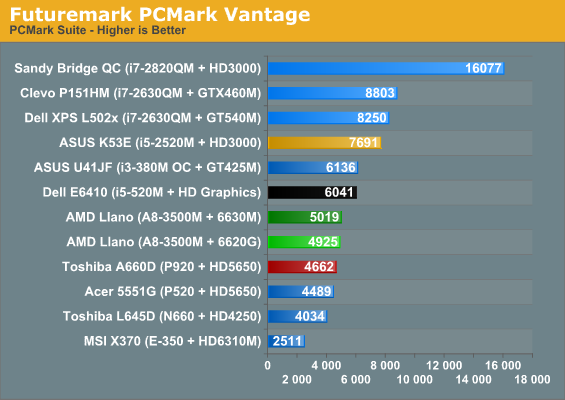
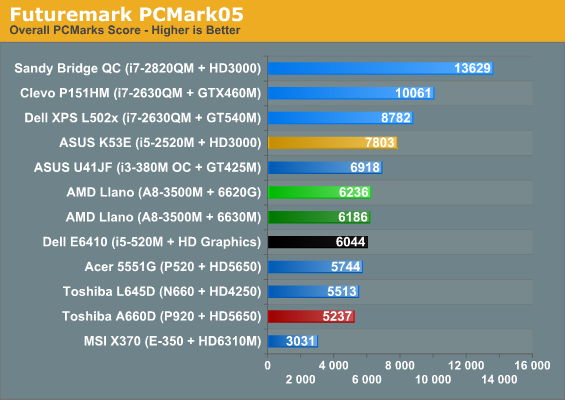
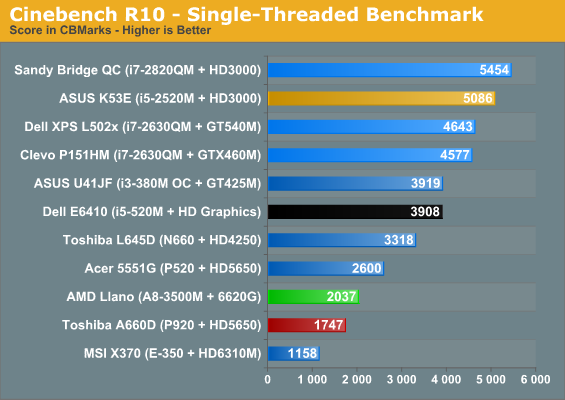

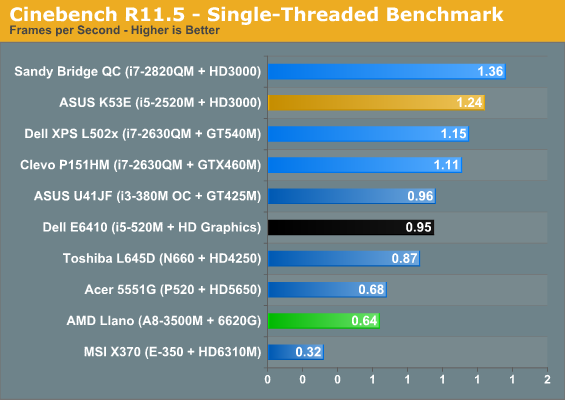
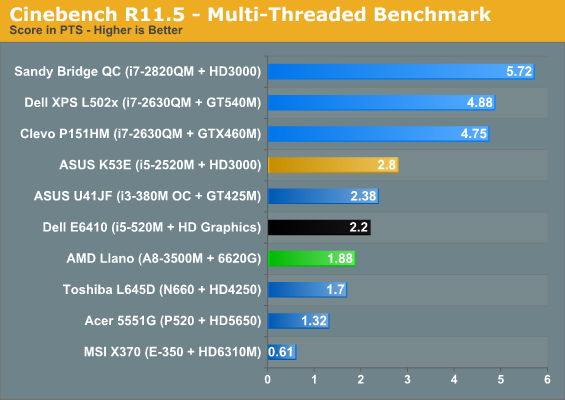
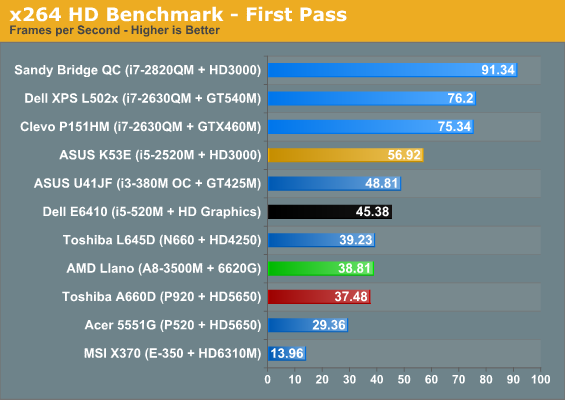
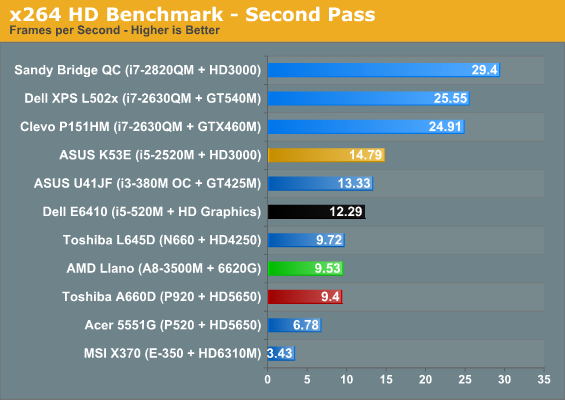
This time we have a more interesting competitor to look at: the Toshiba A660D. AMD says Turbo Core works at speeds of up to 2.4GHz on the A8-3500M, but we have no way of monitoring the actual CPU clocks right now. (CPU-Z if you’re wondering shows a constant 1.5GHz, but AMD says that utility doesn’t currently detect the proper clocks.) When we compare performance results between the Llano notebook and the A660D, we definitely see some differences in performance. Some of that may come from the added L2 cache and other architectural tweaks, but Cinebench R10 in particular shows a healthy 17% performance increase, even with a base clock that’s 7% lower. In the multi-threaded Cinebench result, the lead drops to 10%, which correlates well with how we’d expect Turbo Core to work. PCMark Vantage is still heavily influenced by the storage subsystem, and the storage score of 2950 on the A660D versus 3791 on the Llano suggests the Toshiba HDD is a significant bottleneck.
Looking at other laptops and tests where we’re looking purely at CPU performance, suddenly Llano starts to struggle. The Arrandale i5-520M offers 92% higher single-threaded performance in Cinebench R10 and 48% better single-threaded performance in R11.5; multi-threaded performance also goes to Arrandale, with a 23% lead in R10 and 17% lead in R11.5. x264 also gives Arrandale a decent lead, with i5-520M 17% faster in the first pass and 29% faster in the more intense second pass. The overclocked i3-380M in ASUS’ U41JF tells a similar tale—and both of these laptops are running processors from early last year. When we shift to Sandy Bridge, even without looking at the quad-core parts AMD’s CPU performance is tenuous. The i5-2520M is anywhere from 50 to 150 percent faster depending on which test we look at; even if we toss out the older Cinebench R10 single-threaded result of 150%, R11.5 given the 2520M a 94% lead. In general, then, a moderate dual-core Sandy Bridge i5-series processor looks to be at least 30% faster, so quad-core Llano really only competes with Core i3 and its lower, non-Turbo clocks.
None of the results here are particularly surprising; K10.5 even at 32nm is still largely the same performance. AMD has focused this round up upgrades more on reducing power consumption rather than increasing performance, and that’s a perfectly reasonable approach for a mobile CPU. Most of us probably aren’t doing 3D rendering, CAD/CAM, or unassisted video transcoding on our laptops anyway. It would still be great to see AMD offer up an equivalent to Intel’s Quick Sync; they have the better GPU architecture, but a dedicated decoder like Quick Sync can clearly pay dividends. Outside of that one deficit the reality is that Llano is still plenty fast. Slapping an SSD into Llano will make more of a difference than upgrading an HDD-based Llano laptop to Core i5, so if you’re looking for an inexpensive laptop that can do everything most users need, Llano is very appealing.










177 Comments
View All Comments
JarredWalton - Tuesday, June 14, 2011 - link
Civ5 and TWS2 are both tested with the latest drivers. The K53E was also tested with drivers that are at most a couple months old. Intel current lists the latest laptop drivers as 15.22.1.64.2361 from 4/13/2011, which is what I'm running on the Intel units right now. If there are some newer drivers that I'm missing out on, let me know and I'll go try them.duploxxx - Tuesday, June 14, 2011 - link
Nice review, it seems like there is a lot of work on CF.Actually I reviewed the Liano already months ago, I mentioned in the last mobile reviews that it will be better performing then the Toshiba with the P920 with really good battery performance. So it is a win -win for the budget line anyhow. Top line remains intel for the CPU power.
Regarding the quote:
Now if you want to have your cake and eat it too, the APU to wait for would be Trinity. Due out somewhere in the 2012 - 2013 timeframe, combine a Bulldozer derived architecture with AMD's next-generation GPU architecture and you've got Trinity.
Trinity will not only be an improved GPU it also has the BD core inthere which will offer much more punch. THe reason LIano is late is because of the 32NM process. It could have been released much sooner. Sure they took an outdated K10 and that is the main issue together with the not enough aggressive Turbo for single thread, they should have adapted this more aka BD.
But assumin Trinity is a rather late 2012 project (by stating 2012-2013) you are way way off...
ET - Tuesday, June 14, 2011 - link
Quote probably reflects an increase in pessimism due to recent events. Bulldozer is still not out, and AMD is said to have had a hard time getting clocks up. So sure, we're all hoping to see Trinity early in 2012, but anyone setting their expectations a little farther are less likely to be disappointed.duploxxx - Wednesday, June 15, 2011 - link
didn't i mentioned it would be launch faster then expected?http://www.cpuforever.com/showthread.php?tid=1574&...
the delay of Zambezi BD has nothing to do with real architecture issues.....
ET - Wednesday, June 15, 2011 - link
That's not the sites which posted on it, including Anandtech, said based on what AMD said (that is, that Bulldozer was not up to speed).Jamahl - Tuesday, June 14, 2011 - link
Was that really needed? I mean...really? Who the hell would do that and for what reason?ET - Tuesday, June 14, 2011 - link
I already got my E-350 laptop, but as Jarred says, Brazos just became less interesting. I'll be waiting to see what price point and performance the dual core Llano will have. What impressed me most was battery life, which is competitive with the E-350 laptop, and it'd be interesting to see how small and light Llano laptops will get.The other takeaway I have from this is that as usual I'm impressed at how far Intel has gone with its integrated graphics. Sure Llano gives it a good beating, but that's at the expense of a lot more die space. I imagine that Intel will continue to tweak its 3D cores and I can't wait to see how this race will develop.
Anosh - Tuesday, June 14, 2011 - link
What happened to power consumption?!Some of us get laptops due to the optimization in the power department over similar desktop parts!
JarredWalton - Tuesday, June 14, 2011 - link
Power = [Battery Capacity] / .98 [efficiency] / ([Battery life in minutes] / 60)So if you take the battery life charts, you can determine roughly what the total system power draw is using the above. Or you can look at the "Relative Battery Life" charts and get the same information as Minutes/Wh instead of converting into Watts.
jabber - Tuesday, June 14, 2011 - link
In my work I get a lot of laptops to fix. If there is one game or genre that appears on 80% or more of them its......The Sims.
I also get asked a lot "if I buy this laptop will it play The Sims?"
Never ever been asked if a laptop will play Crysis or any of the games you use.
Just saying.